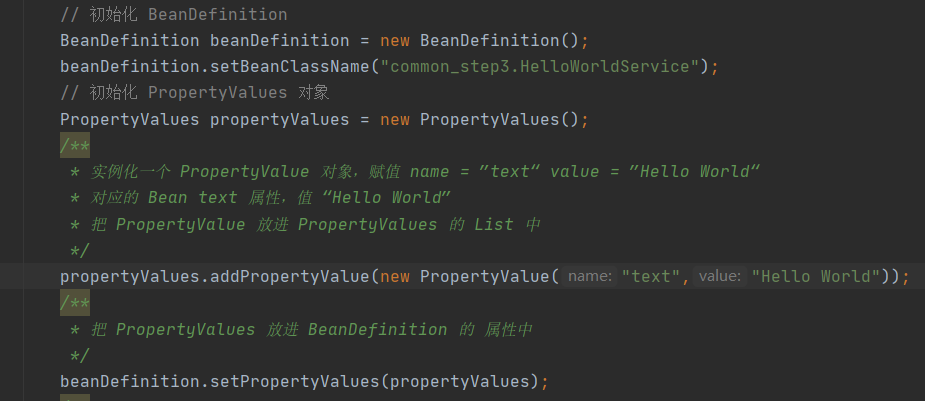用 java 实现 spring 的 IOC 容器
从 step-1 到 step-6 由简入繁
step1
IOC 最基本的两个角色,容器 和 bean 本身,bean 被存放到容器中,需要使用的时候容器将 bean 提供给我们。那么我们需要一个类,作为 容器,存放 bean,最简单的做法是,定义一个 BeanFactory 类作为容器,一个 map 属性以键值对的形式存放 bean name 和 bean 对象
public BeanFactory {
private Map<String,Object> beanMap = new HashMap<String,Object>();
public Object getBean(String name) {
return beanMap.get(name);
}
public void registerBean(String name, Object bean) {
beanMap.put(name,bean);
}
}
现在就可以调用 registerBean 方法把 bean 放入到容器中,getBean 获取 bean了
将上面的方法优化一下,定义一个 BeanDefinition 用来封装 bean。使用对象去封装 bean 的好处是:除了存放 bean 本身,还可以定义其他的属性去存放一些 bean 的其他信息
public class BeanDefinition {
private Object bean;
public BeanDefinition(Object bean) {
this.bean = bean;
}
public Object getBean() {
return bean;
}
}
再将前面的容器对应修改,逻辑还是一样的
public class BeanFactory {
private Map<String, BeanDefinition> beanDefinitionMap = new ConcurrentHashMap<String, BeanDefinition>();
public Object getBean(String name) {
return beanDefinitionMap.get(name).getBean();
}
public void registerBeanDefinition(String name, BeanDefinition beanDefinition) {
beanDefinitionMap.put(name, beanDefinition);
}
}
容器完成了,定义一个类作为 bean,用作测试
public class HelloWorldServiceImpl implements HelloWorldService {
@Override
public void helloWorld() {
System.out.println("hello world");
}
}
example main 示例
- 初始化 BeanFactory 容器
- 初始化一个
HelloServiceImpl对象,存放进BeanDefinition的 bean 属性中 - 以 helloServiceImpl 作为 键(bean name) beanDefinition 作为值存放进 BeanFactory 的 map 中
然后就可以调用 getBean 方法,通过 bean name 得到对应的 bean 对象
public class ExampleMain {
public static void main(String[] args) {
BeanFactory beanFactory = new BeanFactory();
BeanDefinition beanDefinition = new BeanDefinition(new HelloWorldServiceImpl());
beanFactory.registerBeanDefinition("helloWorldServiceImpl",beanDefinition);
HelloWorldService helloWorldService = (HelloWorldService)beanFactory.getBean("helloWorldServiceImpl");
helloWorldService.helloWorld();
}
}
step2
在第一步中,做到了 定义 BeanFactory 容器,定义 BeanDefinition 用来封装 bean,然后初始化 bean 放入容器。最后可以通过 bean name 去获取 bean。我们在初始化 bean 的时候是这么做的:把 HelloWorldServiceImpl 初始化好之后再 set 进属性
BeanDefinition beanDefinition = new BeanDefinition(new HelloWorldServiceImpl());
IOC 的原则是 bean 的初始化应该交给容器去做
这显然不是我们想要的!
如何让容器去初始化 bean 呢?
首先,容器肯定需要知道要初始化哪一个类
step-1 中,在初始化 BeanDefinition 的时候就已经把 bean 实例存放在 BeanDefinition 中了
BeanDefinition beanDefinition = new BeanDefinition(new HelloWorldServiceImpl());
而下面的一步,beanFactory 登记 bean,除了存放进 map,就没有做任何事情
beanFactory.registerBeanDefinition("helloWorldServiceImpl",beanDefinition);
要让容器去初始化 bean,那么在 new BeanDefinition() 的时候就不初始化 bean,但是要存放一些信息,后面 BeanFactory 根据这些信息去初始化 bean
对之前的代码作一些更改:
BeanDefinition 新增属性,beanClassName 存放 bean 的全路径名,beanClass 存放 bean 的 calss 对象,setBeanClassName 的时候,根据全路径,使用反射得到类对象存放到 beanClass 属性中
public class BeanDefinition {
private Object bean;
private Class beanClass;
private String beanClassName;
public BeanDefinition() {
}
public void setBean(Object bean) {
this.bean = bean;
}
public Class getBeanClass() {
return beanClass;
}
public void setBeanClass(Class beanClass) {
this.beanClass = beanClass;
}
public String getBeanClassName() {
return beanClassName;
}
public void setBeanClassName(String beanClassName) {
this.beanClassName = beanClassName;
try {
this.beanClass = Class.forName(beanClassName);
} catch (ClassNotFoundException e) {
e.printStackTrace();
}
}
public Object getBean() {
return bean;
}
}
step-1 的 BeanFactory 是一个 class 对象,为了保证扩展性,把容器特性抽象出来成为一个接口,定义两个必要方法 获取 bean 和 注册 bean
public interface BeanFactory {
Object getBean(String name);
void registerBeanDefinition(String name, BeanDefinition beanDefinition);
}
抽象类 AbstractBeanFactory 实现接口,存放 bean 的 map 在此处定义。这里面定义了一个抽象方法 doCreateBean,这个方法就是我们用来初始化 bean 的。参数 BeanDefinition 封装了类的信息,容器得到类的信息去初始化 bean
public abstract class AbstractBeanFactory implements BeanFactory {
private Map<String, BeanDefinition> beanDefinitionMap = new ConcurrentHashMap<String, BeanDefinition>();
@Override
public Object getBean(String name) {
return beanDefinitionMap.get(name).getBean();
}
@Override
public void registerBeanDefinition(String name, BeanDefinition beanDefinition) {
Object bean = doCreateBean(beanDefinition);
beanDefinition.setBean(bean);
beanDefinitionMap.put(name, beanDefinition);
}
protected abstract Object doCreateBean(BeanDefinition beanDefinition);
}
定义 AutowireCapableBeanFactory 做为一个实现
public class AutowireCapableBeanFactory extends AbstractBeanFactory {
@Override
protected Object doCreateBean(BeanDefinition beanDefinition) {
try {
Object bean = beanDefinition.getBeanClass().newInstance();
return bean;
} catch (InstantiationException e) {
e.printStackTrace();
} catch (IllegalAccessException e) {
e.printStackTrace();
}
return null;
}
}
example main
public class ExampleMain {
public static void main(String[] args) {
// 初始化 BeanFactory
BeanFactory beanFactory = new AutowireCapableBeanFactory();
// 初始化 BeanDefinition
BeanDefinition beanDefinition = new BeanDefinition();
/**
* step1 是直接实例化出来一个 bean,这里把这一步交给了容器,也就是让 BeanFactory 去初始化
* 给 BeanDefinition 中的 类名赋值,全路径名
* BeanDefinition 根据类全路径名称,反射出来一个 Class 对象
*/
beanDefinition.setBeanClassName("common_step2.HelloWorldService");
/**
* 这一步会从 BeanDefinition 中拿到之前存放的 Class 对象,通过 newInstance() 方法实例化出来一个 Bean
* 存放进 BeanDefinition 的 属性中
* 然后把 BeanName 和 BeanDefinition 通过键值对的方式存放进 BeanFactory 的 ConcurrentHashMap 中去
* **/
beanFactory.registerBeanDefinition("helloWorldService",beanDefinition);
/**
* 获取 bean
*/
HelloWorldService helloWorldService = (HelloWorldService)beanFactory.getBean("helloWorldService");
helloWorldService.helloWorld();
}
}
step3
将容器逐步完善,第二步中把实例化 bean 的操作交给了 BeanFactory 容器,实现了 spring 的控制反转,接下来考虑一些另一个特性:依赖注入
一般情况 bean 都是会带有自己的属性的,如何去注入属性呢?
tiny-spring 是这么去做的
在前几步的基础上,新建 PropertyValue 对象和 PropertyValues 对象
PropertyValue
name 属性对应 bean 的属性名称,value 属性对应 bean 的属性值,一个 PropertyValue 对象即对应一个 bean 的属性
public class PropertyValue {
private final String name;
private final Object value;
public PropertyValue(String name, Object value) {
this.name = name;
this.value = value;
}
public String getName() {
return name;
}
public Object getValue() {
return value;
}
}
PropertyValues 存放多个 PropertyValue,此对象会被放进 BeanDefinition
public class PropertyValues {
private final List<PropertyValue> propertyValueList = new ArrayList<PropertyValue>();
public PropertyValues() {
}
public void addPropertyValue(PropertyValue pv) {
//TODO:这里可以对于重复propertyName进行判断,直接用list没法做到
this.propertyValueList.add(pv);
}
public List<PropertyValue> getPropertyValueLists() {
return this.propertyValueList;
}
}
BeanDefinition 中新增一个 PropertyValues 属性
public class BeanDefinition {
private Object bean;
private Class beanClass;
private String beanClassName;
// 新增
private PropertyValues propertyValues;
public void setBean(Object bean) {
this.bean = bean;
}
public Class getBeanClass() {
return beanClass;
}
public void setBeanClass(Class beanClass) {
this.beanClass = beanClass;
}
public String getBeanClassName() {
return beanClassName;
}
public void setBeanClassName(String beanClassName) {
this.beanClassName = beanClassName;
try {
this.beanClass = Class.forName(beanClassName);
} catch (ClassNotFoundException e) {
e.printStackTrace();
}
}
public Object getBean() {
return bean;
}
public PropertyValues getPropertyValues() {
return propertyValues;
}
public void setPropertyValues(PropertyValues propertyValues) {
this.propertyValues = propertyValues;
}
}
step4
经过前三步的逐步优化,已经实现容器实例化 bean 并注入属性值

但是如果一个 bean 有很多属性值的话,代码会写的非常长
所以这一步实现类似 sping 的 xml 配置方式,在 xml 里面配置 bean 名称,bean 路径,bean 属性名,bean 属性值,按照 spring 的方法,新建一个 xml 文件
<?xml version="1.0" encoding="UTF-8"?>
<beans>
<bean name="helloWorldService" class="us.codecraft.tinyioc.HelloWorldService">
<property name="text" value="Hello World!"></property>
</bean>
</beans>
既然有了 xml 文件,那肯定需要去解析 xml 文件,获得各个节点的内容,在前面的基础上,定义 Resource 接口,UrlResource实现接口,此对象的作用是根据 xml 文件的 URL 对象得到 xml 文件的 输入流
/**
* Resource是spring内部定位资源的接口。
* @author yihua.huang@dianping.com
*/
public interface Resource {
InputStream getInputStream() throws IOException;
}
public class UrlResource implements Resource {
private final URL url;
public UrlResource(URL url) {
this.url = url;
}
@Override
public InputStream getInputStream() throws IOException{
URLConnection urlConnection = url.openConnection();
urlConnection.connect();
return urlConnection.getInputStream();
}
}
定义一个 ResourceLoader 类,一个 getResource() 方法,在根路径下根据文件名找到对应的 xml 文件,返回一个 UrlResource 对象
public class ResourceLoader {
public Resource getResource(String location){
/**
* location 为 xml 文件的 路径+名称
* this.getClass().getClassLoader() 表示 classpath 根目录
* 返回一个 URL 对象
*/
URL resource = this.getClass().getClassLoader().getResource(location);
return new UrlResource(resource);
}
}
定义解析 xml 文件的接口BeanDefinitionReader,AbstractBeanDefinitionReader实现接口,一个 map 属性 registry,从 xml 中解析出来,封装好的 BeanDefinition 对象。通过键值对的方式存放在 map 中,一个 ResourceLoader 属性
public interface BeanDefinitionReader {
void loadBeanDefinitions(String location) throws Exception;
}
public abstract class AbstractBeanDefinitionReader implements BeanDefinitionReader {
/**
* 从 xml 中读取到的文件封装到 BeanDefinition 对象之后
* 以 bean name 为键,BeanDefinition 为值得方式放入 此 map 中
*/
private Map<String,BeanDefinition> registry;
/**
* ResourceLoader 对象
* 主要作用为读取 xml 文件,得到 xml 文件的 URl 对象
*/
private ResourceLoader resourceLoader;
protected AbstractBeanDefinitionReader(ResourceLoader resourceLoader) {
this.registry = new HashMap<String, BeanDefinition>();
this.resourceLoader = resourceLoader;
}
public Map<String, BeanDefinition> getRegistry() {
return registry;
}
public ResourceLoader getResourceLoader() {
return resourceLoader;
}
}
具体流程如下
-
XmlBeanDefinitionReader继承AbstractBeanDefinitionReader实现方法 -
loadBeanDefinitions方法中,得到 xml 文件的 输入流,然后去解析 -
doLoadBeanDefinitions方法,通过输入流得到 xml 的Document对象 -
registerBeanDefinitions方法,通过Document对象得到 xml 根节点 -
parseBeanDefinitions方法,通过根节点得到所有的子节点,在循环中,解析每一个子节点 -
processBeanDefinition方法,得到 bean 标签的 name 和 class 的值 -
processProperty方法,再去解析 bean 标签下面的property标签的内容,将得到的 nama 和 value 的值,封装到BeanDefinition中 -
再把
BeanDefinition和 bean name 以键值对的形式存放到 map 属性中
public class XmlBeanDefinitionReader extends AbstractBeanDefinitionReader {
public XmlBeanDefinitionReader(ResourceLoader resourceLoader) {
super(resourceLoader);
}
@Override
public void loadBeanDefinitions(String location) throws Exception {
/**
* 调用继承的 ResourceLoader 的 getResource 方法
* 该方法返回一个 Resource 类型的对象 UrlResource
* 得到 根目录下面的 名为 location 文件的 URL 对象
* 将 URL 对象存放进 UrlResource 中返回
* 调用 UrlResource 对象的 getInputStream 方法得到一个 inputStream 对象
*/
InputStream inputStream = getResourceLoader().getResource(location).getInputStream();
/**
* 解析 xml
*/
doLoadBeanDefinitions(inputStream);
}
/**
* 通过 xml 文件输入流
* 得到 xml 文件的 Document 对象
* @param inputStream
* @throws Exception
*/
protected void doLoadBeanDefinitions(InputStream inputStream) throws Exception {
DocumentBuilderFactory factory = DocumentBuilderFactory.newInstance();
DocumentBuilder docBuilder = factory.newDocumentBuilder();
Document doc = docBuilder.parse(inputStream);
/**
* 解析 bean
*/
registerBeanDefinitions(doc);
inputStream.close();
}
/**
* 通过 Document 对象解析 xml
* @param doc
*/
public void registerBeanDefinitions(Document doc) {
/**
* 得到根节点
*/
Element root = doc.getDocumentElement();
parseBeanDefinitions(root);
}
/**
* 遍历根节点 <beans></beans> 的子节点 NodeList
* @param root
*/
protected void parseBeanDefinitions(Element root) {
NodeList nl = root.getChildNodes();
for (int i = 0; i < nl.getLength(); i++) {
Node node = nl.item(i);
if (node instanceof Element) {
Element ele = (Element) node;
processBeanDefinition(ele);
}
}
}
/**
* 此处的 Element 表示 <bean></bean>
* 获取 bean 标签里的 name 和 class 属性值
* 初始化 BeanDefinition
* @param ele
*/
protected void processBeanDefinition(Element ele) {
String name = ele.getAttribute("name");
String className = ele.getAttribute("class");
BeanDefinition beanDefinition = new BeanDefinition();
/**
* 解析 bean 标签下面的 property 标签,遍历 name value
* 将解析完成的数据封装成 PropertyValue 放进 BeanDefinition 的 PropertyValues 属性中
*/
processProperty(ele,beanDefinition);
/**
* BeanDefinition className 属性赋值,同时反射出 class 对象给 class 属性赋值
*/
beanDefinition.setBeanClassName(className);
/**
* 将 bean name 和对应的 BeanDefinition 对象以键值对的形式存放进本类中的 HashMap 中(继承自抽象类)
* 后面初始化 BeanFactory 并 注册 bean 的时候从这里取值
*/
getRegistry().put(name, beanDefinition);
}
/**
* 解析 <bean></bean> 下面的 <property></property> 中的 name 和 value
* 放进 PropertyValue 中
* 给 BeanDefinition 中的 list 赋值
* @param ele
* @param beanDefinition
*/
private void processProperty(Element ele,BeanDefinition beanDefinition) {
NodeList propertyNode = ele.getElementsByTagName("property");
for (int i = 0; i < propertyNode.getLength(); i++) {
Node node = propertyNode.item(i);
if (node instanceof Element) {
Element propertyEle = (Element) node;
String name = propertyEle.getAttribute("name");
String value = propertyEle.getAttribute("value");
beanDefinition.getPropertyValues().addPropertyValue(new PropertyValue(name,value));
}
}
}
}
上面方法已经将 xml 文件解析完成,BeanDefinition 已经存放进了 map 中
同样的,此时的 BeanDefinition 中的 bean 属性还是空的,bean 未被实例化,接下来只需要从 map 取出数据,再使用 BeanFactory 容器把 bean 放如工厂就行了
AutowireCapableBeanFactory 与 step-3 相同,没有做改动
example main
public class ExampleMain {
public static void main(String[] args) {
// 初始化 BeanFactory
BeanFactory beanFactory = new AutowireCapableBeanFactory();
// 初始化 BeanDefinition
BeanDefinition beanDefinition = new BeanDefinition();
beanDefinition.setBeanClassName("common_step3.HelloWorldService");
// 初始化 PropertyValues 对象
PropertyValues propertyValues = new PropertyValues();
/**
* 实例化一个 PropertyValue 对象,赋值 name = ”text“ value = ”Hello World“
* 对应的 Bean text 属性,值 “Hello World”
* 把 PropertyValue 放进 PropertyValues 的 List 中
*/
propertyValues.addPropertyValue(new PropertyValue("text","Hello World"));
/**
* 把 PropertyValues 放进 BeanDefinition 的 属性中
*/
beanDefinition.setPropertyValues(propertyValues);
/**
* 注入 bean 到容器中,与上一步相同,多了一步给 bean 注入属性值的方法
*/
try {
beanFactory.registerBeanDefinition("helloWorldService",beanDefinition);
} catch (Exception e) {
e.printStackTrace();
}
// 获取 Bean
HelloWorldService helloWorldService = (HelloWorldService)beanFactory.getBean("helloWorldService");
helloWorldService.helloWorld();
}
}
step5
上一步实现了 xml 配置的形式,去解析配置文件,实现 bean 的自动装配,但是有一个问题:无法处理 bean 和 bean 之间的依赖
例如:
HelloWorldService 中有一个 OutputService 对象
public class HelloWorldService {
private String text;
private OutputService outputService;
public void helloWorld(){
outputService.output(text);
}
public void setText(String text) {
this.text = text;
}
public void setOutputService(OutputService outputService) {
this.outputService = outputService;
}
}
OutputService 中有一个 HelloWorldService 对象
public class OutputService {
private HelloWorldService helloWorldService;
public void output(String text){
System.out.println(text);
}
public void setHelloWorldService(HelloWorldService helloWorldService) {
this.helloWorldService = helloWorldService;
}
这种形式的话,使用上一步的方式就无法实现 bean 中注入 另一个 bean,为了处理 baen 和 bean 之间的依赖关系,定义一个 BeanReference 类,当一个类中出现对另一个类的引用时候使用它
public class BeanReference {
private String name;
private Object bean;
public BeanReference(String name) {
this.name = name;
}
public String getName() {
return name;
}
public void setName(String name) {
this.name = name;
}
public Object getBean() {
return bean;
}
public void setBean(Object bean) {
this.bean = bean;
}
}
xml 配置文件按照 sprin 的写法修改,ref 表示对其他 bean 的引用
<?xml version="1.0" encoding="UTF-8"?>
<beans>
<bean name="outputService" class="common_step5.OutputService">
<property name="helloWorldService" ref="helloWorldService"></property>
</bean>
<bean name="helloWorldService" class="common_step5.HelloWorldService">
<property name="text" value="Hello World!"></property>
<property name="outputService" ref="outputService"></property>
</bean>
</beans>
相应的解析 xml 文件的类 XmlBeanDefinitionReader 需要调整,类中解析 property 标签的方法 processProperty 需要对 有 ref 这个属性的标签做相应的操作
之前的解析方式是解析 property 标签的 name 和 value 属性的值对应的存放到 BeanDefinition propertyValues 属性中,这里添加了 如果 property 标签中有 ref 这个属性在就表示,是对另一个 bean 的引用,ref 的值 就为引用的 bean 的 name,创建一个 BeanReference 对象,把 bean name 存放进去,然后把 BeanReference 对象存放到 PropertyValue 对象的 value 属性中,后面就一样的把 PropertyValue 存放到 BeanDefinition 中去
private void processProperty(Element ele, BeanDefinition beanDefinition) {
NodeList propertyNode = ele.getElementsByTagName("property");
for (int i = 0; i < propertyNode.getLength(); i++) {
Node node = propertyNode.item(i);
if (node instanceof Element) {
Element propertyEle = (Element) node;
String name = propertyEle.getAttribute("name");
String value = propertyEle.getAttribute("value");
if (value != null && value.length(P) > 0) {
beanDefinition.getPropertyValues().addPropertyValue(new PropertyValue(name, value));
} else {
String ref = propertyEle.getAttribute("ref");
if (ref == null || ref.length() == 0) {
throw new IllegalArgumentException("Configuration problem: <property> element for property '"
+ name + "' must specify a ref or value");
}
BeanReference beanReference = new BeanReference(ref);
beanDefinition.getPropertyValues().addPropertyValue(new PropertyValue(name, beanReference));
}
}
}
}
完成之后 XmlBeanDefinitionReader 中的 registry map 中就存放了所有的 需要放进 容器的 bean name 和对应的 BeanDefinition 对象
BeanDefinition 对象中的 PropertyValues 属性里的 PropertyValue 对象,value 属性有两种类型:String 或者 BeanReference 对象,下面解析的时候对这两种类型做判断,分别做不同的操作
对 AbstractBeanFactory 做一些调整,getBean 方法从 map 中拿到 bean,如果 bean 不存在,调用 doCreateBean 方法去初始化 bean
同时为了解决循环依赖的问题,我们使用lazy-init的方式,将createBean的事情放到 getBean 的时候才执行,这样在注入bean的时候,如果该属性对应的bean找不到,那么就先创建!因为总是先创建后注入,所以不会存在两个循环依赖的bean创建死锁的问题。
新增一个 list 集合 beanDefinitionNames 存放 bean 的 name,在这里 registerBeanDefinition 所做的只是将bean name 和对应的 BeanDefinition 存放进 map 里面bean name 存放进 list 里面
preInstantiateSingletons 方法用来初始化所有的 bean 到容器中
public abstract class AbstractBeanFactory implements BeanFactory {
private Map<String, BeanDefinition> beanDefinitionMap = new ConcurrentHashMap<String, BeanDefinition>();
private final List<String> beanDefinitionNames = new ArrayList<String>();
@Override
public Object getBean(String name) throws Exception {
BeanDefinition beanDefinition = beanDefinitionMap.get(name);
if (beanDefinition == null) {
throw new IllegalArgumentException("No bean named " + name + " is defined");
}
Object bean = beanDefinition.getBean();
if (bean == null) {
bean = doCreateBean(beanDefinition);
}
return bean;
}
@Override
public void registerBeanDefinition(String name, BeanDefinition beanDefinition) throws Exception {
beanDefinitionMap.put(name, beanDefinition);
beanDefinitionNames.add(name);
}
public void preInstantiateSingletons() throws Exception {
for (Iterator it = this.beanDefinitionNames.iterator(); it.hasNext();) {
String beanName = (String) it.next();
getBean(beanName);
}
}
/**
* 初始化bean
*
* @param beanDefinition
* @return
*/
protected abstract Object doCreateBean(BeanDefinition beanDefinition) throws Exception;
AutowireCapableBeanFactory 中 遍历 BeanDefinition 中 PropertyValue 并将值赋值给 bean 中对应的属性方法,applyPropertyValues 也要做调整
PropertyValue 的 value 可能是一个字符串,也可能是一个 BeanReference 对象。如果对应的是一个 BeanReference 对象,表示 bean 中的该属性是一个其他 bean 的对象,那么就从 容器 中,根据 bean name 名称去得到该对象的实例赋值给 bean。实例还不存在?调用 doCreateBean 方法去创建
protected void applyPropertyValues(Object bean, BeanDefinition mbd) throws Exception {
/*n++;
System.out.println("NO."+n+" ==> applyPropertyValues()");*/
for (PropertyValue propertyValue : mbd.getPropertyValues().getPropertyValues()) {
Field declaredField = bean.getClass().getDeclaredField(propertyValue.getName());
declaredField.setAccessible(true);
Object value = propertyValue.getValue();
if (value instanceof BeanReference) {
BeanReference beanReference = (BeanReference) value;
/**
* 为 bean 注入 bean 的操作,在这一步
* 如果 为 bean1 注入 bean2
* 两个 bean 都需要在放入到容器中
* 等查找到 某一个 bean 中依赖了另一个 bean
* 只需要在容器中找到被依赖的 bean 放入
*/
value = getBean(beanReference.getName());
}
declaredField.set(bean, value);
}
}
example main
public class ExampleMain {
public static void main(String[] args) throws Exception {
/**
* step-5 处理了 bean 和 bean 之间的注入
* 为 bena 注入 bean
*/
// 1.读取配置
XmlBeanDefinitionReader xmlBeanDefinitionReader = new XmlBeanDefinitionReader(new ResourceLoader());
xmlBeanDefinitionReader.loadBeanDefinitions("tinyioc.xml");
// 2.初始化BeanFactory并注册bean
AbstractBeanFactory beanFactory = new AutowireCapableBeanFactory();
for (Map.Entry<String, BeanDefinition> beanDefinitionEntry : xmlBeanDefinitionReader.getRegistry().entrySet()) {
beanFactory.registerBeanDefinition(beanDefinitionEntry.getKey(), beanDefinitionEntry.getValue());
}
// 3.初始化bean
beanFactory.preInstantiateSingletons();
// 4.获取bean
HelloWorldService helloWorldService = (HelloWorldService) beanFactory.getBean("helloWorldService");
helloWorldService.helloWorld();
}
}
step6
之前的 step-1 到 step-5 已经基本实现了 spring IOC 的功能,但是使用起来比较麻烦,回想一下之前使用 spring 的时候一般方法会这样写
ApplicationContext ac = new ClassPathXmlApplicationContext("applicationContext.xml")
HelloWorldService helloWorldService = ac.getBean(HelloWorldService.class);
更加简洁优雅,这一步按照此方式进行优化,定义一个 ApplicationContext 接口继承 BeanFactory 接口
public interface ApplicationContext extends BeanFactory {
}
定义一个抽象类 AbstractApplicationContext 实现 ApplicationContext 接口,refresh 方法在子类进行实现,用来初始化 bean
public abstract class AbstractApplicationContext implements ApplicationContext {
protected AbstractBeanFactory beanFactory;
public AbstractApplicationContext(AbstractBeanFactory beanFactory) {
this.beanFactory = beanFactory;
}
public void refresh() throws Exception{
}
@Override
public Object getBean(String name) throws Exception {
return beanFactory.getBean(name);
}
}
ClassPathXmlApplicationContext 继承抽象类 AbstractApplicationContext实现 refresh 方法,与 step-5 比较,核心代码没有修改只是将初始化AutowireCapableBeanFactory 容器XmlBeanDefinitionReader 解析 xml 文件初始化 bean 的操作 都封装到了这里面
public class ClassPathXmlApplicationContext extends AbstractApplicationContext {
private String configLocation;
public ClassPathXmlApplicationContext(String configLocation) throws Exception {
this(configLocation, new AutowireCapableBeanFactory());
}
public ClassPathXmlApplicationContext(String configLocation, AbstractBeanFactory beanFactory) throws Exception {
super(beanFactory);
this.configLocation = configLocation;
refresh();
}
@Override
public void refresh() throws Exception {
XmlBeanDefinitionReader xmlBeanDefinitionReader = new XmlBeanDefinitionReader(new ResourceLoader());
xmlBeanDefinitionReader.loadBeanDefinitions(configLocation);
for (Map.Entry<String, BeanDefinition> beanDefinitionEntry : xmlBeanDefinitionReader.getRegistry().entrySet()) {
beanFactory.registerBeanDefinition(beanDefinitionEntry.getKey(), beanDefinitionEntry.getValue());
}
/**
* Add by me
* 源代码中没有这一步
*
*/
beanFactory.preInstantiateSingletons();
}
}
example main
public class ExampleMain {
public static void main(String[] args) throws Exception {
/**
* 熟悉的 ApplicationContext
*
*/
ApplicationContext applicationContext = new ClassPathXmlApplicationContext("tinyioc.xml");
HelloWorldService helloWorldService = (HelloWorldService) applicationContext.getBean("helloWorldService");
helloWorldService.helloWorld();
}
}
封装好之后,初始化 bean 只需一行代码就可以完成



评论区